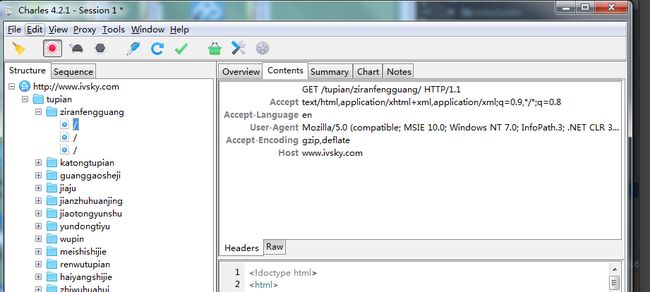利用scrapy框架爬取并下载天堂图片网的图片和数据
1. 通过命令创建项目
scrapy startproject IvskySpider
2. 用pycharm打开项目
3. 通过命令创建爬虫(Terminal中输入以下命令)
scrapy genspider ivsky ivsky.com
4. 配置settings
robots_obey=False
Download_delay=0.5
Cookie_enable=False
5. 在middlewares.py文件中:自定义UserAgentMiddleWare
法一:
可以直接粘现成的
法二:
或者自己通过研究源码实现
6. ivsky.py文件中,开始解析数据
1) 先大致规划一下需要几个函数
2) 函数1跳转到函数2使用 yield scrapy.Request(url,callback,meta,dont_filter)
具体代码如下:
item中数据封装的代码为:
9.useragent相关问题
用charles抓包我们会发现UserAgent并不是我们想要的结果,因此需要,自定义获取useragent函数
但是,结果显示的确实系统的UserAgent,我们可以在settings.py文件中做以下处理,优先使用自定义的useragent

useragent:

scrapy startproject IvskySpider
2. 用pycharm打开项目
3. 通过命令创建爬虫(Terminal中输入以下命令)
scrapy genspider ivsky ivsky.com
4. 配置settings
robots_obey=False
Download_delay=0.5
Cookie_enable=False
5. 在middlewares.py文件中:自定义UserAgentMiddleWare
法一:
可以直接粘现成的
from fake_useragent import UserAgent
class UserAgentMiddleware(object):
"""This middleware allows spiders to override the user_agent"""
def __init__(self):
self.user_agent = UserAgent()
@classmethod
def from_crawler(cls, crawler):
o = cls()
# crawler.signals.connect(o.spider_opened, signal=signals.spider_opened)
return o
# 这个函数不能删,否则会报错
def spider_opened(self, spider):
# self.user_agent = getattr(spider, 'user_agent', self.user_agent)
pass
def process_request(self, request, spider):
if self.user_agent:
# b 转换为二进制,不能改
request.headers.setdefault(b'User-Agent', self.user_agent.random)
法二:
或者自己通过研究源码实现
6. ivsky.py文件中,开始解析数据
1) 先大致规划一下需要几个函数
2) 函数1跳转到函数2使用 yield scrapy.Request(url,callback,meta,dont_filter)
具体代码如下:
# -*- coding: utf-8 -*-
import scrapy
# scrapy框架自带一种解析方式,基于lxml 所以不用导入etree
# form lxml import etree
# 创建文件夹
import os
# 下载图片
import requests
from ..items import ImgInfoItem
class IvskySpider(scrapy.Spider):
name = 'ivsky'
allowed_domains = ['ivsky.com']
# start_url 可以替换为自己需要的网址
start_urls = ['http://www.ivsky.com/tupian/ziranfengguang/']
# 只有parse这个函数是自动调用的
def parse(self, response):
# 这里的response跟之前我们写的不太一样,没有content属性
# print(response.text)
# 调用函数(法一)
# self.parse_big_category()
# 调用函数(法二)
"""
参数1:url,爬取的网址
参数2:callback回调,当网页下载好以后传给谁去解析
参数3:method,默认get
headers
cookies
meta
"""
yield scrapy.Request(
url=response.url,
# 把url的值传递给调用的parse_big_category函数
# 注意parse_big_category后面没有括号!!!
callback=self.parse_big_category,
# scrapy会自动过滤已经爬过的文件,因此设置为True,表示不过滤
dont_filter=True,
)
def parse_big_category(self, response):
"""
函数注释用三个双引号
解析网页大分类
:param response:
:return:
"""
# 以下三种方式都可以,推荐使用xpath
# response.selector.xpath() 简写成 response.xpath()
# response.selector.css()
# response.selector.re()
big_a_list = response.xpath("//ul[@class='tpmenu']/li/a")
for big_a in big_a_list[1:]:
# extract_first :将列表中的元素转换为字符串并且取第0个,如果取不到返回默认值
big_title = big_a.xpath("text()").extract_first("没有标题")
big_href = big_a.xpath("@href").extract_first("没有地址")
big_href = "http://www.ivsky.com" + big_href
# print(big_title, big_href)
yield scrapy.Request(
url=big_href,
callback=self.parse_small_category,
# meta 1.用于传递数据 2.类型为字典
meta={
"big_title": big_title,
},
dont_filter=True,
)
# 解析小分类
def parse_small_category(self, response):
"""
解析网页小分类
response指的是big_href
:param response:
:return:
"""
# 将big_title传递进来
# 法一
# big_title = response.meta.get("big_title")
small_a_list = response.xpath("//div[@class='sline']/div/a")
for small_a in small_a_list:
# extract_first :将列表中的元素转换为字符串并且取第0个,如果取不到返回默认值
small_title = small_a.xpath("text()").extract_first("没有标题")
# 法二
response.meta['small_title'] = small_title
small_href = small_a.xpath("@href").extract_first("没有地址")
small_href = "http://www.ivsky.com" + small_href
# print(small_title, small_href)
yield scrapy.Request(
url=small_href,
callback=self.parse_img_list,
# 法一
# meta={
# "big_title": big_title,
# "small_title": small_title,
# }
# 法二
meta=response.meta,
dont_filter=True,
)
def parse_img_list(self, response):
"""
解析图片缩略图
:param response: response指的是small_href
:return:
"""
img_a_list = response.xpath("//ul[@class='pli']/li/div/a")
for img_a in img_a_list:
detail_href = img_a.xpath("@href").extract_first("没有详细地址")
detail_href = "http://www.ivsky.com" + detail_href
thumb_src = img_a.xpath("img/@src").extract_first("没有图片地址")
thumb_alt = img_a.xpath("img/@alt").extract_first("没有图片名称")
# print(thumb_alt, thumb_src)
response.meta['thumb_src'] = thumb_src
response.meta['thumb_alt'] = thumb_alt
yield scrapy.Request(
url=detail_href,
callback=self.parse_img_detail,
meta=response.meta,
dont_filter=True,
)
def parse_img_detail(self, response):
"""
解析图片详情
:param response:
:return:
"""
# 在最后一个函数中,把所有的数据传递过来
big_title = response.meta.get("big_title").strip()
small_title = response.meta.get("small_title").strip()
thumb_src = response.meta.get("thumb_src").strip()
thumb_alt = response.meta.get("thumb_alt").strip()
img_detail_src = response.xpath("//img[@id='imgis']/@src").extract_first("没有图片详情地址")
# print(img_detail_src)
path = "big/" + big_title + '/' + small_title + '/' + thumb_alt
if not os.path.exists(path):
os.makedirs(path)
picture_name = thumb_src.split('/')[-1]
thumb_name = "缩略图" + picture_name
detail_name = "高清图" + picture_name
# 定义对象
item = ImgInfoItem()
# 将数据封装到item中
item["big_title"] = big_title
item["small_title"] = small_title
item["thumb_src"] = thumb_src
item["thumb_alt"] = thumb_alt
item["img_detail_src"] = img_detail_src
item["path"] = path
# 类似于return 如果用return,效果没问题,但是return以后的代码不执行
# 但yield可返回数据,并且之后的代码照样执行
yield item
with open(path+"/"+thumb_name, "wb") as f:
# thumb_src 缩略图网址
img_response = requests.get(thumb_src)
f.write(img_response.content)
with open(path+"/"+detail_name, "wb") as f:
# img_detail_src 高清图网址
img_response = requests.get(img_detail_src)
f.write(img_response.content)
"""
1.进程:
2.线程:与进程相关,一个进程相当于一个人,一个线程相当于一个脑子
默认线程只有一个,叫主线程
一个线程每次只能做一件事,例如:迅雷 同时下载任务量为1
多个线程可以“同时”做多件事,例如:迅雷同时下载的任务量为5,可以显著提高下载效率
注意:线程不是越多越好,(10个左右)例如:火车站卖票 窗口越多成本越高,速度越快
注意:Scrapy默认使用多线程
注意:python没有多线程
3.协成:负责协助线程的资源切换
"""
item中数据封装的代码为:
# -*- coding: utf-8 -*-
# Define here the models for your scraped items
#
# See documentation in:
# https://doc.scrapy.org/en/latest/topics/items.html
import scrapy
class IvskyspiderItem(scrapy.Item):
# define the fields for your item here like:
# name = scrapy.Field()
pass
class ImgInfoItem(scrapy.Item):
"""
item用于组装爬虫数据
里面的字段根据实际情况定义即可,一般字段名和变量名保持一致
item封装后的数据 可以经过管道做一些数据
"""
big_title = scrapy.Field()
small_title = scrapy.Field()
thumb_src = scrapy.Field()
thumb_alt = scrapy.Field()
img_detail_src = scrapy.Field()
path = scrapy.Field()
9.useragent相关问题
用charles抓包我们会发现UserAgent并不是我们想要的结果,因此需要,自定义获取useragent函数
但是,结果显示的确实系统的UserAgent,我们可以在settings.py文件中做以下处理,优先使用自定义的useragent
DOWNLOADER_MIDDLEWARES = {
# 改为自己在Middleware中添加的获取useragent类
'IvskySpider.middlewares.UserAgentMiddleware': 543,
# 优先选择系统的useragent,下面的一行代码设置禁用系统的useragent
'scrapy.downloadermiddlewares.useragent.UserAgentMiddleware': None
# 数字表示优先级 越小越先执行 如果填为none,表示不执行
}
useragent:
